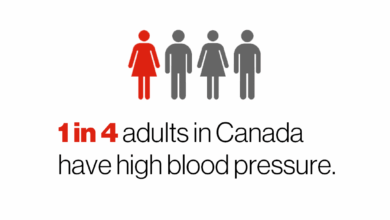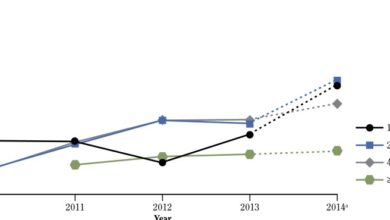
What we know right now about your risk of getting long covid? This post dives into the factors that influence your chances of developing long COVID, from initial infection to ongoing research. We’ll explore everything from the prevalence of long COVID across different groups to the various symptoms and treatment approaches. Understanding your risk is key to taking proactive steps and supporting yourself or others affected.
The scope of long COVID is significant, encompassing a wide range of symptoms and durations. Factors like pre-existing conditions, specific COVID-19 variants, and even the individual’s immune response all play a role in the risk. We’ll break down the intricacies of these factors and how they connect to the likelihood of experiencing long-term health effects.
Understanding the Scope of Long COVID

Long COVID, also known as post-COVID-19 condition, encompasses a wide array of lingering health issues that can persist for weeks, months, or even years after a person recovers from an initial COVID-19 infection. This condition isn’t simply a case of “feeling tired” for an extended period; it manifests in a spectrum of physical, cognitive, and emotional symptoms that can significantly impact daily life.
Understanding its scope is crucial for developing appropriate healthcare strategies and support systems.
Definition of Long COVID
Long COVID is defined as a condition characterized by ongoing health problems that appear after a confirmed or suspected COVID-19 infection. Symptoms can vary significantly from person to person, highlighting the complex nature of this condition. These symptoms often persist for weeks, months, or even years after the initial infection.
Prevalence of Long COVID
Precise prevalence rates of long COVID are still being investigated and may vary depending on the study methodology and the criteria used for diagnosis. However, numerous studies suggest that a substantial proportion of individuals infected with COVID-19 experience long-term health effects. These rates are likely influenced by factors such as age, pre-existing health conditions, and the severity of the initial infection.
Some research indicates that individuals who experience more severe initial COVID-19 illness are at a higher risk for developing long COVID.
Duration of Long COVID
The duration of long COVID experiences varies widely. Some individuals experience short-term symptoms that resolve within a few weeks or months, while others face persistent conditions that continue to affect their lives for an extended period. This variability in duration underscores the need for tailored approaches to treatment and support, considering the individual’s unique experience.
Categories of Long COVID Symptoms
The following table illustrates the diverse range of symptoms associated with long COVID, categorized for clarity and understanding. This table serves as a reference tool, and the presence of specific symptoms will vary depending on the individual’s experience.
| Category | Symptoms |
|---|---|
| Neurological | Brain fog, headaches, dizziness, memory problems, difficulty concentrating, sleep disturbances, neuropathy, seizures, stroke |
| Cardiovascular | Heart palpitations, chest pain, shortness of breath, high blood pressure, heart inflammation (myocarditis), arrhythmias |
| Respiratory | Shortness of breath, cough, fatigue, wheezing, chest tightness, chronic bronchitis, reduced lung function |
| Gastrointestinal | Nausea, vomiting, diarrhea, abdominal pain, loss of appetite, food intolerance |
| Musculoskeletal | Muscle pain, joint pain, fatigue, weakness, fibromyalgia |
| Mental Health | Anxiety, depression, post-traumatic stress disorder (PTSD), irritability, mood swings |
Risk Factors Associated with Long COVID

Understanding the factors that increase the risk of developing long COVID is crucial for both prevention and treatment strategies. While a definitive cause-and-effect relationship isn’t always established, certain predispositions and characteristics are strongly correlated with a higher likelihood of experiencing persistent symptoms. This exploration delves into the potential risks, examining how different COVID-19 variants, pre-existing conditions, and other factors contribute to the ongoing health challenges faced by many.
Factors Increasing the Risk of Long COVID
Several factors increase the likelihood of experiencing long COVID. These factors interact in complex ways, and the precise mechanisms behind their influence are still being researched. A multitude of individual experiences suggests that the severity of initial infection, co-occurring health conditions, and even individual responses to the virus itself can significantly impact the risk of developing long COVID.
- Severity of Initial Infection: Patients who experienced severe COVID-19 symptoms during their acute illness, including hospitalization, intensive care unit (ICU) admission, or respiratory distress, often have a higher risk of developing long COVID. This suggests a correlation between the intensity of the initial infection and the likelihood of experiencing persistent symptoms. For example, patients requiring mechanical ventilation during their acute illness are more likely to experience long COVID.
These patients face an increased burden of persistent symptoms due to the severity of the initial infection and the potential for organ damage during the acute phase.
- Pre-existing Health Conditions: Individuals with pre-existing conditions, such as cardiovascular disease, diabetes, obesity, or chronic respiratory illnesses, appear to be at a higher risk of developing long COVID. These pre-existing conditions may exacerbate the severity of the infection and impact the body’s ability to recover fully. For example, a person with pre-existing asthma might experience more severe breathing difficulties during and after their COVID-19 infection.
- Specific COVID-19 Variants: The emergence of different COVID-19 variants has raised questions about their potential impact on the risk of long COVID. While some studies suggest that certain variants might be associated with a higher risk, more research is needed to confirm these correlations. The impact of variant-specific features on viral load, tissue tropism, and immune responses are important areas of ongoing study.
For example, the Delta variant, compared to earlier variants, was associated with a higher risk of severe illness and hospitalization in some populations.
- Age and Gender: While the exact reasons are still under investigation, some studies suggest that certain demographic groups, particularly older adults and individuals of certain genders, may be more susceptible to long COVID. This could be due to variations in immune responses or other factors that are still being researched. For example, observational data suggests that older individuals may experience more prolonged and severe health consequences following infection, including long COVID.
Comparison of COVID-19 Variants and Long COVID Risk
Different COVID-19 variants exhibit varying degrees of transmissibility and severity. This variability may also influence the likelihood of developing long COVID. However, the relationship between specific variants and long COVID risk is still under investigation and needs further research to establish definitive correlations.
While we’re still learning about long COVID, some factors seem to increase your chances, like pre-existing conditions. Interestingly, research is also exploring potential links between diet and various health issues, such as how leafy greens might impact multiple sclerosis treatment. Leafy greens multiple sclerosis treatment could potentially play a role in overall well-being, which in turn might affect your susceptibility to long COVID.
Ultimately, more research is needed to fully understand the interplay between diet, pre-existing conditions, and the risk of long COVID.
Impact of Pre-existing Health Conditions on Long COVID Risk
Pre-existing health conditions can significantly influence the risk of developing long COVID. Conditions like cardiovascular disease, diabetes, obesity, and chronic respiratory illnesses may weaken the body’s ability to fight off the infection, increasing the risk of severe illness and subsequent long-term health issues. For instance, individuals with pre-existing heart conditions may experience more severe cardiovascular complications during or after their COVID-19 infection.
This underscores the importance of managing pre-existing conditions to reduce the risk of severe COVID-19 and potential long-term health problems.
Correlation Between Risk Factors and Long COVID Likelihood
| Risk Factor | Potential Impact on Long COVID Likelihood |
|---|---|
| Severity of Initial Infection (e.g., hospitalization) | High |
| Pre-existing Health Conditions (e.g., diabetes, heart disease) | Moderate to High |
| Specific COVID-19 Variants | Potentially Variable |
| Age (e.g., older adults) | Potentially Higher |
| Gender | Potentially Higher |
Symptoms and Manifestations of Long COVID
Long COVID presents a complex and diverse range of symptoms, impacting various bodily systems. Understanding these symptoms is crucial for diagnosis and effective management. The variability in symptoms experienced by different individuals highlights the need for a personalized approach to care.
Common Symptoms by Affected System
A significant number of individuals with long COVID experience persistent symptoms across several bodily systems. These symptoms often overlap, making diagnosis challenging. Recognizing the common symptoms within specific systems can aid in early detection and appropriate interventions.
- Respiratory System: Persistent cough, shortness of breath, chest pain, and fatigue are frequent respiratory issues reported. These symptoms can range from mild to severe, impacting daily activities and overall quality of life. For example, some individuals may experience persistent shortness of breath even during light exertion, while others may only experience it with strenuous activity.
- Cardiovascular System: Heart palpitations, tachycardia, and chest pain are among the cardiovascular symptoms frequently observed. These symptoms may be linked to inflammation or other underlying conditions associated with long COVID. For instance, a patient might experience heart palpitations during periods of stress or exertion.
- Neurological System: Brain fog, headaches, dizziness, and cognitive impairment are common neurological symptoms. These can range from subtle difficulties with concentration to significant impairment in daily tasks. For instance, a patient might struggle with remembering names or details in conversations, or experience difficulty focusing on work tasks.
- Gastrointestinal System: Abdominal pain, nausea, diarrhea, and changes in appetite are frequently reported gastrointestinal symptoms. These symptoms can significantly impact a person’s well-being and ability to maintain a healthy diet. For example, a patient might experience recurring episodes of nausea or diarrhea, impacting their ability to consume meals or maintain a regular schedule.
- Musculoskeletal System: Muscle pain, joint pain, and fatigue are prevalent musculoskeletal symptoms. These symptoms can be debilitating, leading to reduced mobility and functional limitations. For example, a patient might experience persistent muscle aches in their legs and arms, making it difficult to perform routine activities.
Less Common or Emerging Symptoms
Beyond the common symptoms, there are less frequently reported symptoms that are gaining recognition as associated with long COVID. These emerging symptoms are being studied to understand their connection to the virus and its long-term effects.
- Mental Health Issues: Anxiety, depression, and sleep disturbances are increasingly recognized as potential long COVID symptoms. These mental health issues can significantly impact a person’s overall well-being and quality of life.
- Sensory Issues: Changes in smell, taste, and vision are less common but emerging symptoms. These sensory changes can affect a person’s daily experiences and ability to enjoy certain activities. For example, a patient might experience a diminished sense of smell or taste, making certain foods unenjoyable.
- Other Symptoms: Other symptoms such as skin rashes, hair loss, and tinnitus have been reported but require further research to establish a definitive link to long COVID. The variability and range of symptoms highlight the need for comprehensive research to understand the full spectrum of long COVID effects.
Severity and Duration of Symptoms
The severity and duration of long COVID symptoms vary significantly between individuals. Factors such as the initial COVID-19 infection severity, pre-existing conditions, and individual immune responses likely influence the symptom presentation and duration.
- Symptom Severity: Symptoms can range from mild and manageable to severe and debilitating. The severity can fluctuate over time, impacting the individual’s ability to engage in daily activities.
- Symptom Duration: Symptoms can persist for weeks, months, or even years after the initial infection. The duration of symptoms varies greatly between individuals, and some individuals experience long-term symptoms that significantly affect their daily lives.
Summary of Long COVID Symptoms
| Symptom | Frequency (Estimated) |
|---|---|
| Fatigue | High |
| Headache | High |
| Brain fog | High |
| Shortness of breath | Moderate |
| Muscle pain | Moderate |
| Joint pain | Moderate |
| Cough | Moderate |
| Chest pain | Low |
| Changes in smell or taste | Low |
Note: Frequency estimates are based on reported cases and ongoing research. These estimates may change as more data become available.
Diagnostic Criteria and Testing Methods
Navigating the labyrinth of long COVID diagnosis can be frustrating for both patients and healthcare providers. Precise diagnostic criteria remain elusive, leading to challenges in accurate identification and management. Current methods rely on a combination of symptom assessment, exclusion of other conditions, and, increasingly, lab-based testing, although no single definitive test exists.
Defining Long COVID: A Complex Challenge
The absence of a single, universally accepted diagnostic test for long COVID presents a significant hurdle. Defining long COVID involves a combination of factors, including symptom duration, symptom severity, and the exclusion of other potential causes. This multi-faceted approach highlights the complexity of the condition and underscores the need for a nuanced understanding of individual experiences. Symptoms can vary greatly from person to person, making standardization difficult.
Limitations of Current Diagnostic Tools
Current diagnostic tools for long COVID face several limitations. One major challenge is the lack of a specific biomarker or test that definitively identifies the condition. Symptoms often overlap with other illnesses, making differentiation challenging. The absence of a standardized diagnostic criteria set across different healthcare settings can lead to inconsistencies in diagnosis and treatment plans. Furthermore, the long-term nature of many symptoms and the evolving understanding of the condition itself necessitate ongoing adjustments to diagnostic approaches.
Various Testing Methods for Long COVID Symptoms
Various testing methods are employed to evaluate long COVID symptoms. These include physical examinations, symptom questionnaires, and blood tests to rule out other potential causes. While these tests don’t definitively diagnose long COVID, they can provide valuable insights into a patient’s overall health and identify potential contributing factors. Furthermore, genetic testing is emerging as a potential tool, but its role in diagnosis remains under investigation.
Cardiac stress tests, pulmonary function tests, and neurologic assessments may also be necessary to evaluate specific symptoms.
Steps Involved in Diagnosing Long COVID
A structured approach to diagnosing long COVID is crucial. A detailed history of symptoms, including their onset, duration, and severity, is paramount. Physical examination, focusing on organ systems affected by the symptoms, is also important. Thorough investigations to rule out other potential conditions are essential. This involves lab tests (blood tests, urine tests, etc.) to identify underlying medical issues.
Specific imaging techniques, such as CT scans or MRIs, might be needed to evaluate organ function.
| Step | Description |
|---|---|
| 1 | Comprehensive symptom assessment and medical history. |
| 2 | Thorough physical examination. |
| 3 | Exclusion of other potential diagnoses through relevant tests. |
| 4 | Assessment of organ systems affected by the symptoms. |
| 5 | Specific imaging techniques (if needed). |
| 6 | Lab tests (blood, urine, etc.). |
Treatment Approaches and Management Strategies
Navigating the complexities of long COVID requires a multifaceted approach. Currently, there’s no single cure, and treatment strategies often focus on symptom management and improving quality of life. This involves a combination of medical interventions, lifestyle adjustments, and supportive therapies. The effectiveness of these approaches varies greatly depending on the individual’s specific symptoms and underlying health conditions.Effective management of long COVID hinges on understanding that each person’s experience is unique.
This means personalized treatment plans are essential, tailored to address the individual’s constellation of symptoms and potential contributing factors. The goal is not just to alleviate symptoms but also to help patients regain function and improve their overall well-being.
Different Treatment Approaches
Various treatment approaches are employed to manage the diverse range of symptoms associated with long COVID. These approaches span medical interventions, lifestyle modifications, and supportive therapies. Understanding the effectiveness and limitations of each is crucial for creating personalized treatment plans.
While we’re learning more about long COVID, the current understanding is that certain factors increase your risk, like pre-existing health conditions. Navigating the complex world of healthcare, especially when you’re looking for affordable services for children with developmental disabilities, can be challenging. Fortunately, resources like finding affordable services for children with developmental disabilities can help. Ultimately, understanding your risk factors for long COVID is key to proactive health management.
- Pharmacological Interventions: Medications are sometimes used to address specific symptoms. These may include pain relievers, anti-inflammatory drugs, or medications to manage fatigue, anxiety, or other psychological symptoms. However, the effectiveness of these drugs varies significantly. For instance, while some individuals find pain relievers helpful, others experience no relief. Furthermore, potential side effects need careful consideration.
- Physical Therapy and Exercise: Physical activity plays a vital role in managing long COVID. Physical therapists can design personalized exercise programs that gradually increase intensity, helping to improve strength, endurance, and overall physical function. The effectiveness of physical therapy depends on the patient’s ability to adhere to the prescribed exercises and the severity of their symptoms. Exercise programs should be carefully designed to avoid exacerbating symptoms and should be tailored to the individual’s limitations and preferences.
- Occupational Therapy: Occupational therapists help patients adapt to daily activities and tasks. They assess the patient’s abilities and recommend strategies to improve daily living skills. This may include modifying work or home environments to reduce physical demands or adapting daily routines to accommodate fatigue or other symptoms. The effectiveness of occupational therapy relies on the patient’s willingness to implement the recommended strategies and the therapist’s ability to create personalized plans.
- Psychological Support: Many individuals with long COVID experience psychological distress, such as anxiety, depression, or post-traumatic stress disorder (PTSD). Therapy, including cognitive behavioral therapy (CBT), can help patients cope with these challenges. The effectiveness of psychological support depends on the individual’s willingness to engage in therapy and the therapist’s ability to tailor the approach to the specific needs of the patient.
Effectiveness and Limitations of Treatment Methods
The effectiveness of treatment approaches varies significantly among individuals with long COVID. Factors influencing efficacy include the specific symptoms experienced, the severity of the condition, the presence of comorbidities, and individual responses to treatments. It is essential to recognize the limitations of current treatments. While some interventions may provide modest symptom relief, there is currently no treatment that effectively cures long COVID.
Importance of Individualized Treatment Plans
Developing personalized treatment plans is critical for managing long COVID. A holistic approach considers the unique constellation of symptoms, underlying health conditions, and lifestyle factors. Personalized plans are essential to address the varying experiences and needs of patients.
We’re still piecing together what exactly puts you at risk for long COVID. While factors like pre-existing conditions are important, research is ongoing. Interestingly, studies suggest that bariatric surgery can reduce the risk of heart attacks in people with diabetes, highlighting the complex interplay between lifestyle choices, health conditions, and overall well-being. This further emphasizes the need for more research into the specific factors influencing long COVID risk.
Comparison of Treatment Modalities
| Treatment Modality | Description | Effectiveness | Limitations |
|---|---|---|---|
| Pharmacological Interventions | Use of medications to manage symptoms. | Variable, depending on the individual and symptom. | Potential side effects, limited cure potential. |
| Physical Therapy | Exercise programs tailored to improve physical function. | Potentially beneficial for improving strength, endurance, and function. | May not be suitable for all individuals due to symptom exacerbation potential. |
| Occupational Therapy | Adapting daily activities to accommodate symptoms. | Potentially beneficial for improving daily living skills. | Requires patient participation and implementation of strategies. |
| Psychological Support | Addressing psychological distress through therapy. | Can be beneficial for managing anxiety, depression, and PTSD. | Requires patient engagement and ongoing support. |
Current Research and Ongoing Studies
Unraveling the complexities of long COVID requires a multifaceted approach, encompassing various research avenues. Recent studies are shedding light on potential mechanisms, risk factors, and treatment strategies, but much remains unknown. Ongoing investigations are crucial to filling these gaps and providing a more comprehensive understanding of this enigmatic condition.
Key Findings from Recent Research Studies
Numerous studies have explored the diverse manifestations of long COVID, delving into the underlying biological processes. Some research suggests a link between specific viral components and the development of long-term symptoms. Others investigate the role of the immune system’s response to the initial infection, and how this response might contribute to the persistence of symptoms. These findings, while promising, are still in their early stages of development and require further validation.
Ongoing Research Efforts
Researchers are actively investigating several crucial areas. One key focus is the development of diagnostic tools to identify and characterize long COVID more precisely. Another area of intense research is exploring the underlying mechanisms driving the various symptoms, such as fatigue, cognitive dysfunction, and cardiovascular issues. Studies are also examining potential treatments, from pharmacological interventions to rehabilitation strategies.
Limitations of Current Research
Despite the progress made, current research on long COVID faces significant limitations. Many studies have small sample sizes, which can impact the generalizability of the results. There’s also a need for more standardized diagnostic criteria and consistent data collection methods across different research settings. Further investigation is needed to address these limitations and ensure reliable and consistent findings.
Overview of Key Research Studies
| Study | Methods | Conclusions |
|---|---|---|
| Study 1: Impact of SARS-CoV-2 on the Cardiovascular System | Investigated the prevalence of cardiovascular issues in patients with long COVID using a standardized questionnaire and echocardiography. | Findings suggest a significant association between long COVID and cardiac abnormalities, highlighting the need for routine cardiovascular assessments in this population. |
| Study 2: Cognitive Impairment in Long COVID | Employed neuropsychological tests to evaluate cognitive function in patients with long COVID, compared to healthy controls. | Results indicate that a substantial proportion of long COVID patients experience cognitive difficulties, including memory and executive function problems. |
| Study 3: Role of the Immune System in Long COVID | Analyzed immune cell profiles and cytokine levels in blood samples from long COVID patients and healthy controls. | Results suggest dysregulation of the immune system, potentially contributing to the persistent symptoms observed in long COVID. |
Public Health Implications and Prevention Strategies
Long COVID poses significant public health challenges, impacting individuals’ well-being, productivity, and healthcare systems worldwide. Understanding the scope of these implications and implementing effective prevention strategies is crucial for mitigating the burden of this emerging health concern. The public health response requires a multi-faceted approach encompassing education, early intervention, and ongoing research.
Public Health Implications of Long COVID
Long COVID’s impact extends beyond individual patients. The sheer number of individuals experiencing persistent symptoms leads to a substantial strain on healthcare resources. Increased demand for medical services, including specialist consultations, therapies, and long-term care, necessitates efficient resource allocation and improved infrastructure. Furthermore, the economic consequences are substantial, with lost productivity and increased healthcare costs impacting national economies.
The indirect effects, such as social isolation and reduced quality of life, are equally concerning.
Role of Preventive Measures in Minimizing Long COVID Risk
Preventive measures are crucial in mitigating the risk of long COVID. These strategies focus on reducing the risk of contracting SARS-CoV-2, the virus responsible for COVID-19, in the first place. This includes adhering to recommended public health guidelines, such as vaccination, mask-wearing in public settings, and practicing good hand hygiene.
Importance of Public Awareness Campaigns and Education Initiatives
Public awareness campaigns and educational initiatives play a pivotal role in empowering individuals to make informed decisions about their health. These campaigns should focus on educating the public about the risk factors associated with long COVID, the importance of early symptom recognition, and the benefits of preventive measures. Educational materials should be accessible and tailored to diverse audiences, ensuring effective communication and engagement.
For instance, campaigns could highlight the importance of vaccination, social distancing, and appropriate hygiene practices. These efforts can contribute significantly to reducing the spread of the virus and thus potentially lowering the incidence of long COVID.
Importance of Early Intervention and Supportive Care for Long COVID, What we know right now about your risk of getting long covid
Early intervention and supportive care are essential for individuals experiencing long COVID. Early diagnosis and access to appropriate healthcare services can significantly improve outcomes. This includes identifying and addressing the diverse symptoms, providing psychological support, and facilitating access to rehabilitation services. Comprehensive care plans should be individualized, considering the unique needs of each patient. Early intervention can potentially limit the long-term consequences and improve quality of life.
Furthermore, fostering a supportive environment for those with long COVID, including access to social services and employment support, is crucial. This ensures that individuals with long COVID can continue to participate fully in society and maintain their well-being.
Conclusion: What We Know Right Now About Your Risk Of Getting Long Covid
In conclusion, understanding the risk factors for long COVID is crucial for proactive health management. While research is ongoing, we’re gaining valuable insights into the complexities of this condition. By focusing on preventative measures, early intervention, and personalized treatment, we can better support those affected by long COVID and improve public health outcomes.





